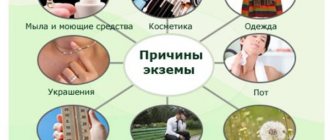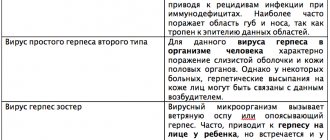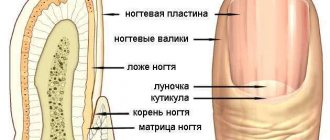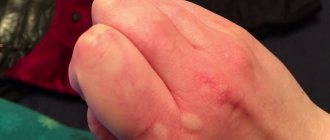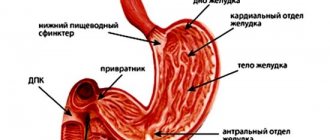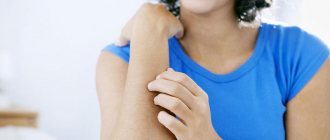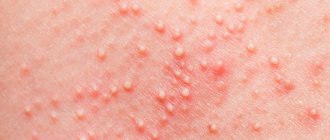Often, unpleasant symptoms in the form of rashes on the baby’s body throw not only young but also experienced parents into panic, and most of them immediately begin treatment without resorting to the help of doctors. You should not rush into such actions, because some alarming signs may indicate dangerous processes in a small organism. In order to correctly determine how dangerous a rash on a baby’s neck can be, a photo with explanations will certainly help you understand some of the features of these manifestations.
Causes in children, newborns
This disease occurs as a reaction to overheating of the skin and body. A child's skin is much thinner than an adult's. It is better supplied with blood, overheats faster and is more sensitive. Children are more susceptible to heat rash than adults. This is due to the fact that their thermoregulation mechanisms and sweat glands are not fully formed.
Sweating is a natural mechanism through which proper thermoregulation of the body occurs. Without it, it is impossible to avoid harmful overheating when the temperature rises.
For example, during the course of diseases such as:
- angina;
- ARVI;
- rubella;
- flu;
- pneumonia.
If you sweat too much, the secretion-producing glands may become clogged. In children, the ducts that remove secretions from the body are fully formed only by the age of 6. Their blockage leads to prickly heat.
Miliaria in a child, the symptoms and treatment of which are discussed in this article, occurs against the background of pathogenic bacteria. If hygiene is not observed, microorganisms begin to actively multiply on wet and sticky skin from sweat.
In newborns, heat rash often occurs due to tight swaddling, as well as wearing diapers. The baby's skin is not sufficiently ventilated. Long-term wearing of disposable diapers is especially unfavorable. A greenhouse effect is created between the skin and the waterproof fabric. This is an ideal environment for infections and fungi.
It is better to use diapers as rarely as possible and in cool weather, for example at night.
In older children, this problem occurs due to wearing clothes made of unsuitable fabric. In the summer heat, it is not recommended for this reason to wear anything made of synthetic fabric. It is better to choose cotton and loose-fitting clothes. Overweight children suffer more from heat rash. They tend to sweat more often than others.
Causes of rashes
Allergic rash in an infant
A rash on the head of a baby in the first weeks of life is not always a manifestation of any pathology. In most cases, it is explained by the residual influence of maternal hormones and the lack of regulation of one’s own hormonal system. Doctors call this rash neonatal cephalic pustulosis, or baby acne. As the body adapts to changed living conditions, all its systems come into order, and the skin gradually cleanses. As a rule, the skin condition returns to normal at 6-7 weeks of life without the use of any medications.
In addition to neonatal pustulosis, a rash on the head of an infant may have the following causes:
- Toxic erythroderma of newborns.
- Allergy to food. With artificial feeding, this may be a reaction to formula milk; with breastfeeding, it may be a reaction to the nursing mother consuming certain allergenic foods (chocolate, citrus fruits, strawberries, etc.).
- Allergy to medications used by both the child and his nursing mother, or chemicals - soap, washing powders used in washing children's clothes.
- Atopic dermatitis is a congenital increased reaction to exposure to allergens.
- A rash on the face and head of a newborn can also be caused by heat rash when the excretory ducts of the sweat glands are blocked. Appears in warm and humid environments.
- Seborrheic dermatitis, localized in the area of the scalp under the hair, occurs in varying degrees of severity in every fourth 1-2 month old baby, so it is considered normal.
Most rashes are physiological rather than pathological in nature. Usually they disappear on their own after a certain time or after the causes that caused them are eliminated.
Among the certainly pathological most common situations that can cause a rash are infectious diseases of a bacterial or viral nature. Thrush, which affects the scalp, as well as the eyelids, eyebrows and mucous membranes of the mouth, is also an infection. A child can become infected with a fungus at birth, passing through the mother's birth canal.
Crystalline prickly heat: distinctive features
This type of heat rash most often affects infants. They are small (1-2 mm) white or pearlescent bubbles. After they burst, irritation and peeling remain.
Comparison of symptoms of different types of heat rash in a child. Traditional methods and drug treatment are discussed in the article.
It affects children's skin mainly in the area of the body:
- neck;
- faces;
- torso.
The crystalline form is not accompanied by itching, but requires immediate elimination. Infection can easily penetrate through microdamages caused by inflammation.
Why does a hormonal rash appear?
The only reason is the natural adaptation of a small organism to a new environment, outside the womb.
This is the so-called “release” of excess hormones that the fetus received during pregnancy and is absorbed by the baby during breastfeeding. This period is also called the infant sexual crisis.
In newborns, both boys and girls, it is manifested by swelling of the mammary glands, swelling in the genital area, and hormonal rash. In women, spotting similar to menstruation may appear. All processes are natural and should not cause much concern to parents. Moreover, such manifestations do not require drug treatment.
Photo
Miliaria rubra
With this type, many small red identical blisters and nodes appear on the skin. The liquid inside the formations is cloudy in color. A characteristic feature of prickly heat is redness and severe itching around the rash. It becomes especially strong when the ambient air temperature rises.
Miliaria rubra is localized in places subject to friction from clothing:
- groin area;
- armpits;
- skin folds.
Papular vesicular rash with chickenpox in children
Chickenpox is a viral infection that is spread by airborne droplets. Children of preschool and primary school age are at risk. Characteristic signs of the disease are: fever, rashes, which are accompanied by severe itching .
A papular vesicular rash first appears on the head, then spreads throughout the body, except the palms and soles. The elements of the rash are a spot that turns into a papule, and then into a vasicle. They are distinguished by a red halo of skin infiltration and filled with clear liquid.
With chickenpox, vesicular rashes are chaotic . They occur on the entire surface of the body, and are accompanied by an increase in body temperature.
A rash can form on the mucous membranes of the larynx, genitals, and conjunctiva of the eyes. On the second day of illness, the vesicles become less red and convex. Over the next couple of days, the rashes dry out and crust over. After 1-2 weeks they dry out completely and fall off on their own.
With chickenpox, rashes form within 5-6 days. The complete disappearance of the crust occurs within 20 days . In their place, red spots remain, which disappear over time.
What does the localization of the rash on the neck, face, back, legs, arms, armpits, groin indicate?
Favorite places for rashes are in skin folds:
- on the neck;
- armpits;
- in the groin.
Miliaria in a child is localized in places that are least ventilated. Symptoms of the disease appear almost immediately. The sooner you start treatment, the faster the disease will go away.
However, it can occur not only in skin folds, but also on the arms, legs, and back. This is caused by excessive sweating. Wearing unsuitable clothing can cause heat rash along with other factors.
Heat rash in a child, the symptoms and treatment of which often occur on the face, should be started as early as possible. It can occur in hot weather. Especially if you use cream. As a rule, creams clog already narrow ducts, causing inflammation.
Vesicular rash photo
Vusicular rash appears on the body in the form of red spots, blisters, ulcers, nodules, and pimples . They can cover the entire body or individual areas. The occurrence of such rashes is the main symptom of an infectious disease. The disease may be accompanied by burning, itching, and high body temperature.
Rashes can appear in separate spots with clear contours and form lesions. Vesicular rash blisters contain blood and pus.
When the first signs of rashes appear, which differ in side symptoms, you should consult a specialist. He will prescribe effective treatment depending on the nature of the infection.
The most common are:
- Chickenpox affects the entire body. The bubbles that form after rupture become crusty.
- Hives are characterized by the appearance of red bumps that protrude above the skin. It is characterized by severe itching.
- Scarlet fever occurs in the form of red spots that appear on the folds of the arms, legs, and abdomen.
- Measles appears as small rashes behind the ears and forehead, which spread to the stomach and chest.
- Rubella appears on the face as small red spots. Then they spread throughout the body.
How to distinguish prickly heat from other diseases?
Miliaria has similar symptoms to other diseases. For successful treatment of the disease, it is necessary to make a correct diagnosis in time. Heat rash in a child is often confused with an allergy. An allergic rash occurs in a baby upon contact with an allergen. As a rule, this occurs after eating certain foods.
The intestines of a small child are enzymatically undeveloped, so allergens and toxins accumulate in the body. All this contributes to the appearance of a skin rash - an external manifestation of an allergy. Allergies, as a rule, are triggered in advance by some external factor, which is the cause.
It could be:
- introduction of new complementary foods;
- excessive consumption of any product;
- external contact with an allergen (for example, if you are allergic to washing powder).
Miliaria is preceded by one thing – excessive sweating. As a rule, this occurs at elevated air temperatures or excessive physical activity. To distinguish allergies from prickly heat, you need to pay attention to the location. Miliaria often occurs in folds of the skin, in areas of friction with clothing.
Common places where allergies occur:
- cheeks;
- forehead;
- chin;
- stomach;
- limbs.
Allergies are often accompanied by other symptoms:
- runny nose;
- headache;
- characteristic cough.
With allergies, there are often no clearly defined elements; with prickly heat, the elements have their own border.
Miliaria is often confused with the manifestation of infectious diseases, such as:
- measles;
- scarlet fever;
- chicken pox;
- rubella.
Measles begins to manifest itself with the appearance of characteristic elements on the inner surfaces of the cheeks. They look like whitish pimples against a red border. Scarlet fever rashes have a dry surface to the touch. Scarlet fever is accompanied by high fever with sore throat. These symptoms of prickly heat are not typical. If they occur, you must immediately call a doctor.
Chickenpox is an infectious disease that occurs when a child enters the body of the human herpes virus type 3. The chickenpox rash may start with a few watery blisters and then spread throughout the body. Papules begin forming as a rash similar to a pimple.
Then it is filled with a translucent liquid with a virus multiplying inside it. Such elements are usually larger than in prickly heat. Gradually the papule becomes a vesicle. A large vesicle bursts, forming erosion. There are no such symptoms with prickly heat. Chickenpox often occurs against a background of high fever, accompanied by migraines and severe itching.
Before the rash appears, the child loses appetite, becomes lethargic, and mobility decreases. The state of the body at this moment is similar to the manifestations of ARVI.
A sharp and strong increase in body temperature (in severe forms it even reaches a hyperthermic crisis) is accompanied by a simultaneous period of rash. With rubella, the rash is localized mainly on the face, buttocks and extensor surfaces. Rubella, unlike prickly heat, occurs with lymphadenitis.
rash on the neck of a newborn
Even in the maternity hospital, my daughter was “supplemented” with baby formula, and later the bottle became the only food - I wrote about this in the article “About breastfeeding.” After discharge, we left our child on the same formula. Over time, I began to notice rashes on my face and neck, but our pediatrician assured me that this happens to all newborns and that it will pass - “Burn it with brilliant green!” They burned it and waited, but the rash did not go away, but spread more and more along the neck, ears, chest and lower down the body. And again I heard - “It will pass, it’s prickly heat!” It's been quite a month or a month and a half since the rash started. (My mother, immediately seeing my daughter’s red cheeks, made a diagnosis in Soviet style: “Yes, she has diathesis, go to the doctor”)
As soon as my daughter started having severe weeping on her neck and behind her ears—the smell was unpleasant and the appearance was unattractive—I began to openly put pressure on our doctor. At the next appointment about the “rash” that turned into all this disgrace, I said that IT WILL NOT PASS, as she assured us, but only gets worse and then…..attention!!!!! shock!!!! She tells us in a calm tone: “Yes, now you have an allergy.” I am in severe bewilderment - the first bell rang for me (but, as it later turned out, not very loudly). Conclusion - our doctor simply left the first signs of an allergic reaction to chance and did not take ANY measures to eliminate it. Further - worse. Measures were taken, but as it turned out later (after my long months of treating my daughter and studying specialized literature), these measures only worsened the situation, since the sequence of prescribing “strong” anti-allergy drugs was not followed.
Instead of gradually getting rid of all this scourge, we were immediately given the strongest casein mixture (which is generally almost an extreme case before the amino acid mixture). The result is constant vomiting, fountaining, screaming and crying from malnutrition and indigestion. BUT!!!! Even to this they calmly told me: “This is not vomiting, but regurgitation. You, mommy, are exaggerating everything, take sedatives.” I'm in another SHOCK!!! HOW???? The child is almost 3 months old and I learned to see the differences between regurgitation and vomiting, and regarding sedatives, I categorically disagreed - THE BEGINNING OF THE ALLERGY WAS MISSED BY THE PEDIATRIC, and not by my emotions. Of course, everything cannot be described in one article.
We had two more incidents with this doctor: when I called her to the house due to the child’s high temperature (37.3) and his crying, but it turned out that with such a temperature there is no need to call doctors, they are not made of iron and also get tired to go to all sorts of “false calls from hysterical mothers” (these are not the words of a doctor, thank God, but the essence that can only be conveyed this way). I was once again advised to take sedatives. And the last, third case - temperature 39, crying, sniffles with water - called again, as it turned out - this time it pleased and did not falsely cause, they prescribed vanilla syrup and nasal drops for purulent snot, which are prescribed for older children, for our current allergy age and in very advanced cases. A CURTAIN!!!
Even complaints against this doctor with a request to change him to another, more competent in pediatrics, did not produce results - “This is the best pediatrician in our clinic” - this was the answer of the head. Since then, I trust pediatric doctors with great caution - I mainly look at the situation, at the child, take into account my vast experience in dealing with various symptoms of diseases and listen to my intuition. And, you know, I have never missed a shot and have no regrets.
We did see an allergist, and here - praise and honor - an excellent doctor, very attentive - this immediately became clear and my intuition confirmed it!! Not everything is as bad as we first got it!!!
We are still struggling with manifestations of allergies (rashes on the skin after eating something) - I monitor, observe, apply, give the necessary drops, which really help us. But this is a completely different story)))) I will describe in other articles our journey with atopic dermatitis in more detail)))
All the best and good specialists!!!!! (They definitely exist, you just need to use your instincts and filter all the recommendations)))
Treatment methods
If heat rash in a child is not neglected and treated in a timely manner, it goes away quickly and leaves no complications. The approach to the various types of this disease should be comprehensive. It is better not to self-medicate, but to consult a pediatrician or dermatologist. Both home remedies and drugs from the pharmacy help in combination.
The duration of therapy can be completely different, it all depends on the type of miliaria, the severity of the disease, and the individual characteristics of the child. Miliaria in a child, with proper identification of symptoms and treatment, is cured in 4-5 days.
However, it can easily return if the accompanying factors are not removed:
- tight clothing made of breathable fabrics;
- stuffy indoor microclimate with high humidity;
- lack of hygiene;
- Rare bathing of the baby.
What reasons can trigger the appearance of redness?
Doctors warn parents not to try to independently determine the factor that caused the formation of spots on the baby’s back. There are many reasons that cause the appearance of this symptom, and not all of them are safe for children's health.
The most common causes of redness:
- Parasitic or infectious infection. Red, rough spots on a child’s back are often accompanied by a rash that merges into one large formation. The baby complains of unpleasant itching or burning; with careful observation, you can notice other signs of the disease - abdominal pain, fever, problems with stool.
- Diseases of the circulatory system. In this case, the redness will have a bluish tint. When lightly pressed, the spot becomes lighter.
- Allergic reaction. Redness is combined with profuse rashes that spread over the most sensitive areas of the body. If the allergen is not immediately identified, the irritation may become chronic or cause severe dermatitis.
- Mistakes in hygiene. Incorrectly selected detergent, infrequent bathing, and excessive sweating of the child lead to clogging of the pores, which results in inflammatory processes. The back is covered with abundant small spots that cause discomfort - burning and itching, which intensify at night.
Red, rough spots on a child’s back usually indicate a viral disease. The main signs of infection are chills or fever, general weakness, loss of appetite, and attacks of nausea. In this case, you should not hesitate to consult a doctor - delay threatens the rapid development of the disease.
Home Remedies
There are a number of home remedies that are quite effective in the complex treatment of prickly heat.
Soda lotions
Baking soda is a universal remedy that effectively fights for the beauty and cleanliness of the skin.
To prepare you need:
- 200 ml warm water;
- 2 tbsp. l. soda
Dissolve the soda in water, stirring the mixture well. The resulting solution is used to treat the affected areas of the child’s skin at least five times a day. After the skin has been treated, a special moisturizing cream is applied to it to speed up healing.
Bay decoction
Bay leaf has long been known as an excellent antiseptic and antifungal agent.
Cooking method:
- Boil 1 liter of water in a saucepan.
- Throw 15 pcs. bay leaf.
- Boil over low heat for about 20 minutes.
The cooled broth is added to the baby’s bathing water, in which the child is bathed for about 20 minutes. The course of treatment with laurel is designed for 10 days, but after just a few procedures the baby becomes noticeably better.
Infusion from the series
Effectively relieves itching, irritation, unpleasant symptoms and redness.
To prepare you will need:
- 1 liter of water;
- 5 tbsp. l. successions.
Place the dried herb in a jar and pour boiling water over it. We insist everything for half an hour. Add this infusion to the bath and bathe the child in it for 30 minutes.
Chamomile decoction
Chamomile is rightfully considered a storehouse of health. Skin problems are another area where this wonderful green healer can help.
To prepare chamomile infusion you will need:
- 250 ml water;
- 2 tbsp. l. pharmaceutical chamomile.
The decoction must be prepared in a water bath for half an hour. The cooled liquid is used to wipe skin with prickly heat.
Potassium permanganate, salt, iodine and starch protect health
A slightly diluted solution of manganese is well suited for getting rid of prickly heat. To do this, you need to prepare a pink solution in a small container. Pour the prepared liquid into the bath in which the child will bathe. Manganese has a drying effect, so it must be used carefully.
Water-salt compresses help dry out inflammation and relieve itching of the skin. You need to dilute the salt in boiled water. Use gauze to wipe off the inflammation several times a day. Iodine solution: a cotton swab dipped in an aqueous solution can also effectively and safely help a child with prickly heat. It’s easy to prepare: drop a few drops of iodine into a glass of water.
Among folk remedies, potato starch also copes well with rashes. Pour 90 g of starch into a glass of boiled water. This mixture should be poured into a bathtub with water and bathed the child. Without rinsing or drying, you need to let your baby's skin air dry. Potato starch can be used effectively for prickly heat as a powder.
Pharmacy ointments
Ointment for prickly heat is prescribed by pediatricians quite often. Only external treatment applies to uncomplicated forms of the disease. In severe cases, ointments are used in combination with other methods.
Popular pharmacy ointments include:
- Bepapten. This wound healing ointment is recommended for children of any age. It has no contraindications, except for individual intolerance. The ointment is produced by the pharmaceutical company Bayer and is of German quality. Thanks to the dexpanthenol included in the composition, an active process of regeneration of the baby’s tissues occurs. The product should be used daily, avoiding contact with mucous membranes.
- Zinc ointment. The main component of this ointment is zinc liniment, thanks to which the treatment occurs. It has a quick effect on the affected skin, drying and healing it. Apply it in a thin layer to previously washed and dried skin of the affected areas. It is recommended to grab a little healthy skin to prevent the disease from spreading to it. Vaseline, which is part of the ointment, covers the surface with a thin film, preventing infectious agents from entering the wounds.
- Desitin. This is a hypoallergenic antimicrobial agent that relieves inflammation well. This ointment can also be used by newborns; it does not cause harm during the treatment process. Desitin dries well and relieves inflammation. It also acts as a prevention for the subsequent occurrence of diaper rash. Desitin should be used 3 times a day, applied to dry, clean skin.
- Tetracycline ointment. This is a more serious remedy containing an antibiotic. Tetracycline ointment is used strictly as prescribed by the doctor. For more complicated, deep forms, antibiotic medications cannot be avoided. This ointment is approved for use in children over 8 years of age. It is applied 1-2 times a day.
- Levomekol. This drug contains an active substance that regenerates the skin. It has the property of penetrating deeply into tissues. The ointment is effective in the presence of purulent processes. Levomekol can be used in children only after prior consultation with a doctor. The drug is used morning and evening for at least 5 days.
Medicinal creams
Creams have a less greasy consistency along with an effect similar to ointments.
The most popular pharmacy creams:
- Calamine. The cream is effective against heat rash in childhood. It dries, soothes irritated skin and has a pronounced cooling effect.
- Sudocrem. This is a universal assistant and copes well with problems such as prickly heat. Sudocrem regenerates, reduces inflammation, heals. Since the cream is quite oily, apply it directly to the inflammation. It is also a good antiseptic and helps prevent skin infections. Thanks to the lanolin contained in the composition, the cream softens and soothes tissues. Benzyl cinnamate is the main medicinal substance that effectively kills bacteria and regenerates the skin.
- Emolium. A product based on effective herbal ingredients. It can even be used in infants. Emolium not only heals, but also moisturizes the baby’s skin well. Apply it several times a day.
- Mustela. The cream is recommended for getting rid of prickly heat. It dries out the skin very much, so to avoid overdrying, apply carefully, avoiding healthy tissue.
Oral medications
These drugs include antihistamines. They are primarily aimed at relieving swelling and itching.
These may be medications prescribed by a doctor:
- Suprastin;
- Cetrin;
- Tavegil.
Antihistamines are especially often prescribed for prickly heat.
In cases where a bacterial infection is associated with the disease, the pediatrician prescribes antibiotics.
These are drugs based on:
- azithromycin;
- erythromycin;
- amoxicillin.
In the case of tablets, self-medication is unacceptable.
What to do if redness is detected - doctors’ recommendations
If you discover redness on your baby’s back, which is accompanied by additional symptoms such as a runny nose or general malaise, it is recommended to immediately inform your pediatrician. To select the most effective treatment therapy, it is necessary to conduct research, which is only possible in laboratory conditions.
You should not take medications that lower your temperature - this is evidence that the small body is trying to cope with the disease on its own. It is recommended to resort to antipyretic medications only in case of fever or chills. After taking syrup or tablets, call a doctor immediately.
Prevention
To avoid illness, special preventive measures are necessary.
| Preventive measure | Description |
| Maintaining hygiene | It is necessary to ensure the cleanliness of the child’s skin and clothes. |
| Creating a comfortable room temperature | It is necessary to ventilate the room in a timely manner and do wet cleaning. In hot weather, you can lower the air temperature using the air conditioner to 20 degrees. Air humidity should be about 60%. |
| Water treatments | In summer, it is necessary to bathe children at least 2 times a day with water at a comfortable body temperature. |
| Staying outside | In summer, it is better to walk with children in the morning and evening hours. It is not recommended to be in the sun during hot weather. |
| Choosing the right clothes | It is better to give preference to natural fabrics; there is no need to overly wrap the child. |

